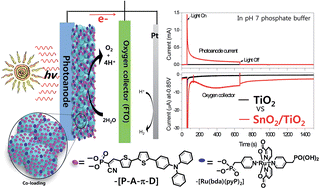An aqueous, organic dye derivatized SnO2/TiO2 core/shell photoanode†
Abstract
Visible light driven water splitting in a dye-sensitized photoelectrochemical cell (DSPEC) based on a phosphonic acid-derivatized donor–π–acceptor (D–π–A) organic dye (P–A–π–D) is described with the dye anchored to an FTO|SnO2/TiO2 core/shell photoanode in a pH 7 phosphate buffer solution. Transient absorption measurements on FTO|TiO2|–[P–A–π–D] compared to core/shell, FTO|SnO2/TiO2(3 nm)|–[P–A–π–D], reveal that excitation of the dye is rapid and efficient with a decrease in back electron rate by a factor of ∼10 on the core/shell. Upon visible, 1 sun excitation (100 mW cm−2) of FTO|SnO2/TiO2(3 nm)|–[P–A–π–D] in a phosphate buffer at pH 7 with 20 mM added hydroquinone (H2Q), photocurrents of ∼2.5 mA cm−2 are observed which are sustained over >15 min photolysis periods with a current enhancement of ∼30-fold compared to FTO|TiO2|–[P–A–π–D] due to the core/shell effect. On surfaces co-loaded with both –[P–A–π–D] and the known water oxidation catalyst, Ru(bda)(pyP)2 (pyP = pyridin-4-methyl phosphonic acid), maximum photocurrent levels of 1.4 mA cm−2 were observed which decreased over an 10 min interval to 0.1 mA cm−2. O2 was measured by use of a two-electrode, collector–generator sandwich cell and was produced in low faradaic efficiencies with the majority of the oxidative photocurrent due to oxidative decomposition of the dye.

- This article is part of the themed collection: Water splitting and photocatalysis

 Please wait while we load your content...
Please wait while we load your content...